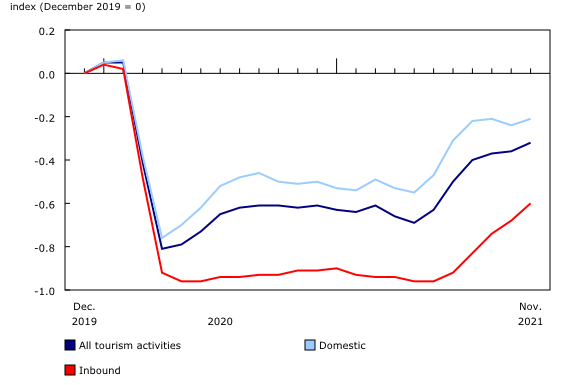Canadian Tourism Activity Tracker, November 2021
Archived Content
Information identified as archived is provided for reference, research or recordkeeping purposes. It is not subject to the Government of Canada Web Standards and has not been altered or updated since it was archived. Please "contact us" to request a format other than those available.
Released: 2022-02-08
Highlights
In November, overall tourism activity in Canada was 31.6% below the level reached in November 2019, before the pandemic. This was the sixth consecutive month of improvement since such activity hit a lull in May, and the highest level since the pandemic started in March 2020.
With the continued easing of travel restrictions over the summer and into the fall, along with the further re-opening in many provinces, including more stores, restaurants, and arts and entertainment venues, it appeared that tourism was on track for recovery in November.
Visit the Canadian Tourism Activity Tracker tool to interact with the data.
Poised for recovery, but new variant lurking
By last November, Canada's borders were open to all fully vaccinated international travellers while, domestically, vaccination take-up was increasing across the country. This went hand-in-hand with broad-based economic growth in November that included accommodation services expanding 7.1%, led by higher activity in traveller accommodation services, and food services and drinking places up 2.0%.
However, in late November 2021, the World Health Organization declared a new variant of concern, Omicron, prompting Canada to implement new travel restrictions. While not yet impacting Canadian tourism activity in November, the new variant was already lurking.
Tourism firing on all cylinders
Tourism activity was subdued at the start of 2021, as travel restrictions were tightened to combat new COVID-19 variants. Temporary re-openings in March provided a reprieve of sorts before additional lockdowns were put in place last spring. Since dipping to 68.5% below its pre-pandemic level in May 2021, overall tourism activity has increased relative to the base period for six consecutive months, with November 31.6% below its pre-pandemic level.
As restrictions eased and vaccination rates rose over the summer, domestic activity (i.e., Canadians travelling within Canada) began to drive a recovery. In the fall, when Canada's borders were opened to all fully vaccinated international travellers, inbound activity (i.e., from international visitors) began to bolster the recovery. Compared with pre-pandemic 2019, November's domestic activity was down 21.1% and inbound activity was down 60.3%, each at the highest level since March 2020.
Provincial recoveries mixed
Typically, there is a lull in tourism in November, between the end of the summer travel season and the start of holiday travel and winter vacations. However, with testing and quarantine no longer required for fully vaccinated international travellers, over 120,000 overseas residents arrived in Canada during November 2021. This surge in international visitors was felt more in some provinces than others.
In the east, inbound activity in Prince Edward Island (-0.52) and New Brunswick (-0.53) was back to almost half of its pre-pandemic level. While inbound activity also rebounded in Nova Scotia, domestic activity seemed to be more or less stalled in November. Out west, domestic activity was higher in most provinces except British Columbia, where flooding events curtailed inbound activity.
Note to readers
The Canadian Tourism Activity Tracker is part of a shift at Statistics Canada from measuring the economic impacts of the pandemic to assessing the recovery. The tracker combines data from multiple sources, including counts of international travellers, domestic and international commercial aircraft and surface movements, as well as hotel occupancy rates and restaurant sales.
When combining these data sources, each series is first normalized using a ratio method that removes seasonality and allows comparison with the same month from the 2019 base. Then weights are used to combine these normalized values into a single estimate for a given month and geography. The weights are determined based on the data series correlation with overall tourism; the higher the correlation, the larger the weight.
The domestic tourism value is calculated using domestic-related data, while the inbound value uses international-related sources. The two values are combined proportionately based on pre-pandemic National Travel Survey and Visitor Travel Survey data, with the level set to zero for each month in the 2019 base year. For a given month in subsequent years, a tracker value above zero indicates that tourism activity is greater than the 2019 base, while a value below zero indicates the opposite.
As an experimental product, caution is warranted when interpreting these estimates. As such, tracker estimates should be viewed as preliminary and are subject to revision. With more data sources being considered along with new methods, this may entail the need for further revisions.
Products
The product "Canadian Tourism Activity Tracker," part of the Data Visualization Products series (71-607-X), is now available.
Contact information
For more information, or to enquire about the concepts, methods or data quality of this release, contact us (toll-free 1-800-263-1136; 514-283-8300; infostats@statcan.gc.ca) or Media Relations (statcan.mediahotline-ligneinfomedias.statcan@statcan.gc.ca).
- Date modified:


